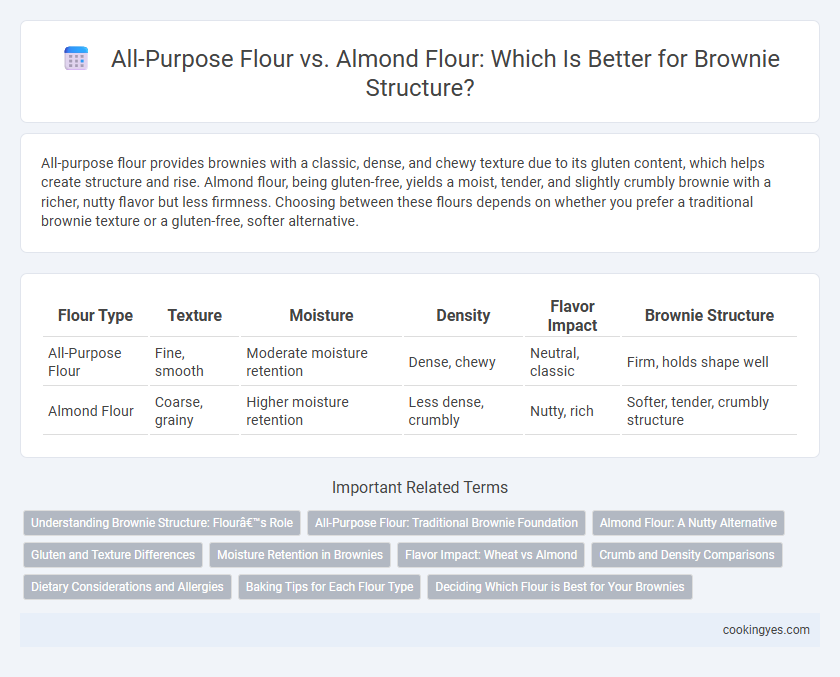All-purpose flour provides brownies with a classic, dense, and chewy texture due to its gluten content, which helps create structure and rise. Almond flour, being gluten-free, yields a moist, tender, and slightly crumbly brownie with a richer, nutty flavor but less firmness. Choosing between these flours depends on whether you prefer a traditional brownie texture or a gluten-free, softer alternative.
Table of Comparison
| Flour Type | Texture | Moisture | Density | Flavor Impact | Brownie Structure |
|---|---|---|---|---|---|
| All-Purpose Flour | Fine, smooth | Moderate moisture retention | Dense, chewy | Neutral, classic | Firm, holds shape well |
| Almond Flour | Coarse, grainy | Higher moisture retention | Less dense, crumbly | Nutty, rich | Softer, tender, crumbly structure |
Understanding Brownie Structure: Flour’s Role
All-purpose flour provides the gluten network essential for a dense, chewy brownie structure, creating the characteristic firmness and bite. Almond flour, lacking gluten, results in a more tender, crumbly texture by introducing moisture and fat without the same structural support. Understanding these differences helps bakers adjust recipes to achieve either traditional fudgy brownies or moist, delicate batches with enhanced flavor from almond flour.
All-Purpose Flour: Traditional Brownie Foundation
All-purpose flour provides the classic structure and chewy texture essential to traditional brownies, delivering a balanced gluten network that supports rise and firmness. This flour's moderate protein content ensures optimal moisture retention and crumb development, creating a familiar dense yet tender bite. Using all-purpose flour results in reliable, consistent brownies with a rich, buttery taste and a slightly crisp exterior.
Almond Flour: A Nutty Alternative
Almond flour offers a moist and tender crumb in brownies due to its higher fat content compared to all-purpose flour, creating a rich, nutty flavor profile ideal for gluten-free baking. It lacks gluten, which means brownies made with almond flour may be denser and require binding agents like eggs or xanthan gum to maintain structure. Using almond flour results in brownies with a softer texture and enhanced nutritional value, including higher protein and healthy fats.
Gluten and Texture Differences
All-purpose flour contains gluten, a protein that provides elasticity and structure, resulting in dense and chewy brownies. Almond flour is gluten-free, producing a more tender, moist texture but with less rise and firmness. Choosing between the two impacts brownie structure significantly, with all-purpose flour offering traditional firmness and almond flour yielding a softer crumb.
Moisture Retention in Brownies
All-purpose flour provides a denser crumb and better structure in brownies due to its higher gluten content, which also aids in moisture retention for a chewy texture. Almond flour, being gluten-free and higher in fat, results in a moist but more delicate brownie with a tender crumb that can sometimes be crumbly. Moisture retention in brownies made with almond flour comes from its natural oils, whereas all-purpose flour relies on gluten development for moisture absorption and retention.
Flavor Impact: Wheat vs Almond
All-purpose flour provides a classic, neutral base that allows the rich chocolate flavor of brownies to shine, contributing to a dense and fudgy texture. Almond flour imparts a subtle nutty sweetness and moistness, enhancing the overall flavor complexity but resulting in a lighter, more tender crumb. The choice between wheat and almond flour significantly influences the brownie's flavor profile and texture, with wheat offering a traditional, robust taste and almond delivering a nuanced, aromatic experience.
Crumb and Density Comparisons
All-purpose flour creates a denser, chewier brownie structure with a tight crumb due to its moderate protein content, which develops gluten and provides elasticity. Almond flour results in a moister, more tender crumb with increased density but a slightly crumbly texture, as its lack of gluten leads to less structural support. When balancing fudginess and firmness, all-purpose flour delivers classic brownie chewiness, while almond flour offers a richer, moist bite with a softer, more cake-like consistency.
Dietary Considerations and Allergies
All-purpose flour provides a traditional, chewy brownie structure suitable for most diets but contains gluten, posing concerns for those with celiac disease or gluten sensitivity. Almond flour offers a gluten-free alternative with a denser, fudgier texture and higher protein and healthy fat content, making it ideal for paleo or low-carb diets but unsuitable for nut allergy sufferers. Choosing between these flours depends on dietary restrictions and allergy considerations, impacting both nutrition and brownie consistency.
Baking Tips for Each Flour Type
All-purpose flour provides a sturdy, chewy brownie texture due to its higher gluten content, making it ideal for traditional dense brownies. Almond flour, being gluten-free and moisture-rich, yields a softer, more crumbly structure, requiring adjustments such as reducing added fats and slightly increasing baking powder to improve rise and stability. For best results, evenly sift all-purpose flour before mixing, and when using almond flour, incorporate eggs or binders to enhance cohesion and prevent crumbly outcomes.
Deciding Which Flour is Best for Your Brownies
All-purpose flour provides a dense and chewy structure ideal for classic brownies, thanks to its balanced protein content that develops gluten. Almond flour creates a moist, tender crumb with a slightly nutty flavor, making brownies softer but less structured due to its lack of gluten. Choosing between all-purpose and almond flour depends on whether you prioritize traditional texture or gluten-free, moist richness in your brownies.
All-Purpose Flour vs Almond Flour for Brownie Structure Infographic

 cookingyes.com
cookingyes.com